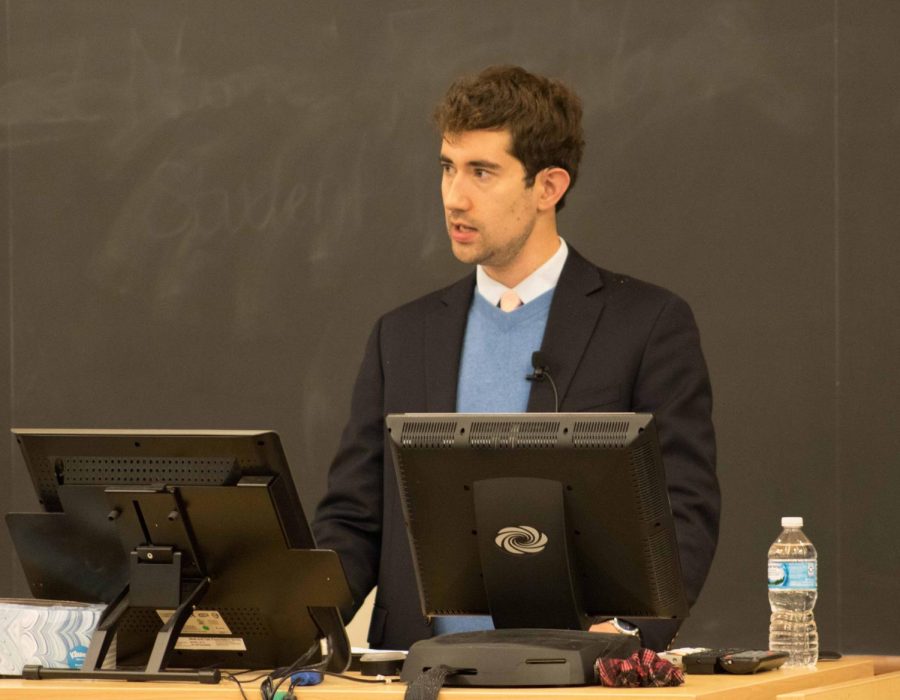Holocaust Museum speaker visits UNI
Eric Schmalz, community manager for the History Unfolded project at the United States Holocaust Museum visited to give a speech on anti-semitism.
Nov 12, 2018
In the wake of recent acts of anti-Semitic violence in the United States, UNI students, faculty and members of the Cedar Falls community were given the unique opportunity to learn about the media’s differing reactions to anti-Semitism between the first and second World Wars.
On Tuesday, Nov. 6 at 7 p.m., Eric Schmalz, community manager for the History Unfolded project at the United States Holocaust Museum, gave a lecture titled “‘The Gauntlet Has Been Thrown:’ Newspapers, Op-Eds, and American Responses to Anti-Semitism” in Sabin Hall’s Segebarth Auditorium.
Stephen Gaies, English professor and director of UNI’s Center for Holocaust and Genocide Education said that while Schmalz’s talk was scheduled weeks prior to the Oct. 27 massacre at the Tree of Life synagogue in Pittsburgh, the contents of Schmalz’s presentation were now more crucial than ever.
“We’re witnessing an unprecedented wave of anti-Semitism that’s affecting not only America but Europe and worldwide,” Gaies said.
The lecture focused on three influential American leaders centered around the Midwest: Henry Ford, Charles Lindbergh and Father Charles Coughlin. Schmalz discussed the anti-Semitic ideas they spread and how the media reacted to this language during the 20’s, 30’s and 40’s.
Schmalz started his lecture discussing Lindbergh, explaining his life and controversies, leading up to his disputed America First speech in Des Moines, where Lindbergh cited America’s three biggest threats pushing them into war as the British, the Roosevelt Administration and the Jews.
“Reactions were not monolithic,” Schmalz said. He presented articles both in defense of and opposed to Lindbergh’s speech as he did with all three controversies.
Schmalz used primary sources found through History Unfolded. He described History Unfolded as a “citizen history” database project that asks nationwide participants to look through newspaper archives for articles to upload about the pre-WWII Nazi threat, ran by the United States Holocaust Museum in Washington, D.C. A current exhibition at the museum entitled Americans and the Holocaust features a “Nazism in the News” section that includes data collected by History Unfolded. Schmalz used pictures from it to suppliment his presentation. The project was launched in 2015 and will continue until 2021.
Schmalz then transitioned into discussing tension and xenophobia in the U.S. between the two world wars.
“U.S. participation [in WWI] came at a great cost,” Schmalz said, and referenced the war’s 116,000 American casualties.
According to Schmalz, the issue of U.S. being an international peacekeeper was put in question due to its rejection of the Treaty of Versailles and the fear of communism, popular isolationist ideologies and reinstating the Ku Klux Klan. Five hundred lynchings were recorded nationwide between 1918 and 1933.
Schmalz explained that xenophobia in this era also led to the rise of the eugenics movement, forced sterilization and race-biased immigration quotas, which furthered prejudice towards minorities deemed “undesirable.”
This era also saw a boom in mass communication. Two thousand newspapers were in daily print, the majority of which targeted specific ethnic or religious groups. Schmalz said these newspapers, along with newsreels shown before movies, were how the public learned about the world around them.
Automobile tycoon Ford purchased “The Dearborn Independent” newspaper in 1919, rebranding it as “The Ford International Weekly,” and used the platform to distribute both anti-war and anti-Semitic commentary. According to Schmalz.
Schmalz said that Adolf Hitler plagiarized Ford’s publication in “Mein Kampf.” After Ford gained negative media attention, he published a formal apology, retracted his statements and ceased publication soon after. Hitler later awarded Ford with the Grand Cross of the German Eagle, the highest honor Nazi Germany could bestow upon foreign sympathizers, which Ford chose to accept in a public ceremony.
This decision was heavily scrutinized by the press, which led to a boycott of Ford cars and another public statement released by Ford about the value of Jewish refugees to the American workforce, claiming he was not sympathetic to Nazism. The legitimacy of this statement was also publicly criticized.
Coughlin was a favored American radio minister when his on-air sermons turned anti-Semitic, making claims that the Nazis persecution of Jews was justified. This sparked a censorship debate in the media when some radio stations fought for the right to approve Coughlin’s script before broadcast. Schmalz used images from newspapers in Chicago and Boone, Iowa to demonstrate the mixed messages Midwesterners were receiving from their opinion columns.
The evening closed with a Q&A session between Schmalz and his audience and closing remarks from Gaies, who continued to note that “these are the same issues we face today” in regards to racism and media bias.
This lecture was part of a four-day tour Schmalz had in Iowa, beginning at Ames Public Library the night prior, and concluding with two days spent at Drake University as part of their Holocaust Education Week. It was sponsored by the Campus Outreach Lecture Program of the United States Holocaust Memorial Museum, Jack, Joseph and Morton Mandel Center for Advanced Holocaust Studies, supported by the Leonard and Sofie Davis Fund.
UNI’s Center for Holocaust and Genocide Education’s next event is a screening of “Across the Waters,” a film depicting Holocaust-era Danish Jews’ escape to Sweden. This event is free and open to the public at 10 a.m. and 7 p.m. on Nov. 15 at the Hearst Center for the Arts.









